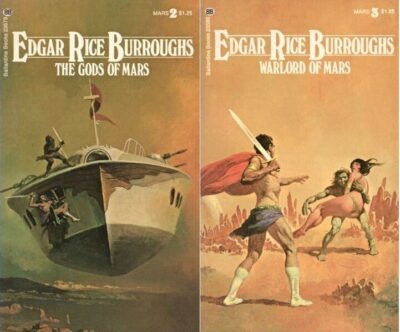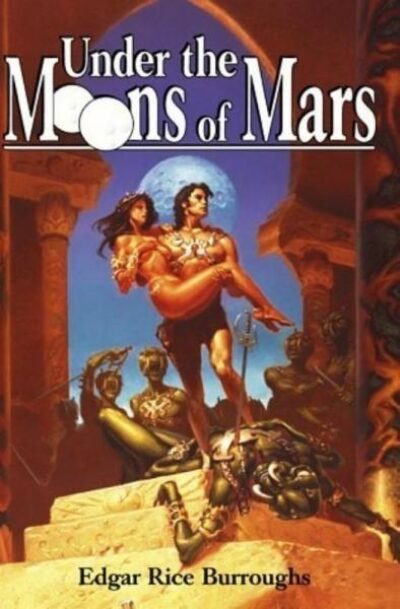1913’s The Gods of Mars is the second volume in Edgar Rice Burroughs’ Barsoom series.
Tragically separated from his beloved Martian Princess Deja Thoris when he was transported back to Earth, John Carter has worked out how to deliberately work the trick of interplanetary displacement he inadvertently experienced in A Princess of Mars. It’s back to Mars — or as its inhabitants call it, Barsoom — for Virginian John Carter.
When one considers how small Mars is compared to the whole of the universe, manifesting in the wrong region isn’t such a huge error. Unfortunately for Carter, he has landed in the Valley Dor, from which escape is surely impossible.
But who would want to escape Heaven?
As chance would have it, the very first person Carter meets in a region of Barsoom Carter has…
1913’s The Gods of Mars is the second volume in Edgar Rice Burroughs’ Barsoom series.
Tragically separated from his beloved Martian Princess Deja Thoris when he was transported back to Earth, John Carter has worked out how to deliberately work the trick of interplanetary displacement he inadvertently experienced in A Princess of Mars. It’s back to Mars — or as its inhabitants call it, Barsoom — for Virginian John Carter.
When one considers how small Mars is compared to the whole of the universe, manifesting in the wrong region isn’t such a huge error. Unfortunately for Carter, he has landed in the Valley Dor, from which escape is surely impossible.
But who would want to escape Heaven?
As chance would have it, the very first person Carter meets in a region of Barsoom Carter has never visited, one far from his usual haunts, is old friend Tars Tarkas. The Green Martian explains that they are in the Valley Dor.
Every Barsoomian outside the Valley Dor knows that it is, to quote Tars Tarkas:
the valley of love and peace and rest to which every Barsoomian since time immemorial has longed to pilgrimage at the end of a life of hate and strife and bloodshed,”
Every Barsoomian inside the Valley Dor knows that the valley is the opposite of all that. The ravenous monsters that thrive in the valley kill and eat most naïve visitors. Survivors are enslaved by the cruel, white skinned Therns.
The Therns have been running their scam for thousands of years. Until now, nobody who entered the valley can ever escape. However, until now, none of the people who entered the valley were John Carter, a man whose martial prowess is matched by his super-Barsoomian strength and his capacity to convert strangers (such as the maid Thuvia) into allies.
There are, of course, unforeseen complications, such as the fact that there is another group of Martians, the Black Pirates, who treat the Therns as the Therns treat other Martians, with the added indignity that Therns are not just enslaved but eaten. Above the Black Martians, Issus, self-proclaimed GODDESS OF LIFE ETERNAL… who is an ancient woman somehow even more evil than the Black Pirates she rules.
Despite these impediments, Carter does of course win his way to freedom, returning to distant Helium… where Deja Thoris is nowhere to be seen. Deja Thoris has set off on a quest to find Carter in the one place he could be without word of him reaching Helium: the Valley Dor.
Carter must rescue his beloved princess. Too bad that almost immediately on reaching Helium, Carter was detained. How can Carter possibly rescue his princess if Carter is in prison?
oOo
I blame two things for this review:
-
Working my way through Outgunned Adventure, which is a pulp-era cinematic roleplaying game that could very easily be used to run planetary adventure games.
-
Encountering paperbacks of The Gods of Mars and *The Warlord of Mars *with the Gino D’Achille cover art I associate with this series of books.

Surely, these books couldn’t be as terrible as I remembered them to be!
Of course, they were. The prose is purple, the plots driven by unlikely coincidence, and most vexingly, The Gods of Mars ends on a cliffhanger that was left for The Warlord of Mars to resolve.
In fact, my original plan was to review both novels in this review, but I just could not force my way through two Edgar Rice Burroughs novels back-to-back. Not even short Edgar Rice Burroughs could.
Still, the book wasn’t without its positive elements, not least of which is the heartening revelation that even crap can be extremely popular, as long as it’s the right crap at the right time. That’s something that should comfort the world’s mediocre-to-terrible authors. Chose your moment and you could be rolling in dough, as will your extremely litigious descendants.
As well, I was impressed by the nuanced view of religion Burroughs offers. Religious authorities aren’t all the ruthless conmen some cynics would have you believe. A lot of them are as gullible as their marks, and while some commit terrible crimes, others commit even worse atrocities. There’s a complex range of behavior on display here.
Finally, I discovered something while looking for the cover art Michael Whelan posted to Bluesky [2]. The last time I read these books was in 2002, for the Science Fiction Book Club. I recommended that Gods and its sequel be combined into one volume, as they are two halves of the story. The SFBC did indeed publish an omnibus, including the first volume as well. That’s even better.

The Gods of Mars is available (for free!) here (On Gutenberg).
1: Carter is somehow immortal and also someone whose forefathers were from Virginia.
USA delenda est.
2: Whelan posted the cover after I read the book. It was ERB week, I guess. The cover was, it turned out, for a later book, Thuvia, Maid of Mars.

That isn’t gratuitous nudity, as one might find on a Diadem novel. Martians (or rather, Barsoomians) run around starkers save for pouches and decorations. Some cover artists ignore that detail. Whelan, who actually reads the books he illustrates, does not.